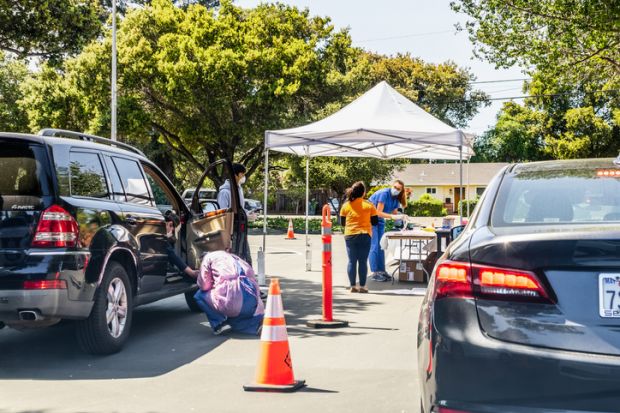Cutting face-to-face teaching is the most effective way to reduce coronavirus transmission on campuses, according to a study which found that about a fifth of students could catch the virus by the end of the first term if additional protections were not put in place.
The epidemiological modelling, which used anonymised student data from the University of Bristol as a test case, also found that in such a scenario almost 1,000 students would be infectious on the last day of term, a time when many would be preparing to travel back to family homes.
However, the study, published on the preprint server medRxiv, also suggests that drastically cutting face-to-face teaching, if used with other measures such as increased social distancing, could cut infection rates by 75 per cent.
The modellers, from Bristol and the University of Exeter, used data on factors such as where students lived and their year of study combined with information from a previous survey on the typical number of social contacts made by students.
Based on a campus population of 28,000 at Bristol, and assuming only general guidelines on social distancing and self-isolation were followed, they predict that 5,760 students would catch the virus in the first term.
“Without additional control measures, 74 per cent of students would be infected by the end of the academic year,” the paper adds.
It goes on to consider the potential effect of various different interventions, including the use of “Covid security” measures such as additional social distancing and the use of face masks, cutting the amount of face-to-face teaching, restricting the number of students sharing facilities in accommodation and mass testing.
Taken on its own, the researchers found that cutting face-to-face teaching contacts to a minimal level “was the single most impactful intervention investigated…including scenarios in which the number of cases in the student population was driven to zero”.
The effect of other measures was more variable, the research suggests, with mass testing potentially effective in scenarios where the virus was being passed easily between people but at “a substantial cost in terms of the number of students self- isolating”. Tests would also need to be performed relatively frequently for it to be an effective measure.
It suggests that different measures should be used in combination for maximum effect, something that could then “effectively control transmission in the student population”.
The research, which was referenced in an influential paper from the Scientific Advisory Group for Emergencies (Sage) on how returning students could spread Covid-19 this autumn, stresses how first-years would be the drivers of any outbreak.
“Our findings highlight the importance of monitoring first-year students and halls of residence in particular,” the medRxiv paper says.
“In our analysis, first-year students experienced the highest rates of infection and dominate the early part of the outbreak due to the high levels of mixing in halls of residence.
“In practice, students in larger residences are allocated into shared flats or living circles, potentially limiting widespread transmission. Maintaining social distancing between living circles within residences is paramount for maintaining Covid-19 control.”
This conclusion may have fed into updated advice that the government issued to universities last week, in which it suggests that each floor of a hall of residence should be treated as a single household.
The modelling also makes clear that its findings depend hugely on assumptions about the infectiousness of asymptomatic cases among students compared with those suffering with symptoms.
Its central finding is based on asymptomatic cases being half as infectious as symptomatic cases, but the paper points out that variations in this could have an important effect on the mix of control measures needed.
The paper also points out that its central “baseline” finding on student infection rates would also result in a median of zero deaths from the disease, given the low morbidity rate of younger people.
But it adds that “given the age distribution of students, and the high likelihood of asymptomatic infection, staff and surrounding communities are likely to experience higher levels of morbidity than the students themselves”.
“Although by-and-large students fraternise with students, they do pose some risk to more vulnerable groups within the university such as staff with co-morbidities, or to their local community. Safeguarding all is a high priority.”
Find out more about THE DataPoints
THE DataPoints is designed with the forward-looking and growth-minded institution in view
Register to continue
Why register?
- Registration is free and only takes a moment
- Once registered, you can read 3 articles a month
- Sign up for our newsletter
Subscribe
Or subscribe for unlimited access to:
- Unlimited access to news, views, insights & reviews
- Digital editions
- Digital access to THE’s university and college rankings analysis
Already registered or a current subscriber? Login










